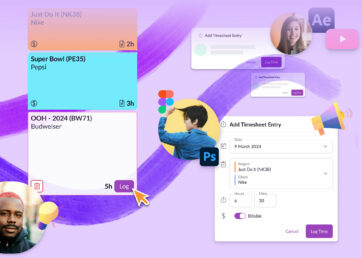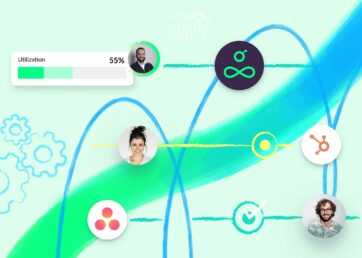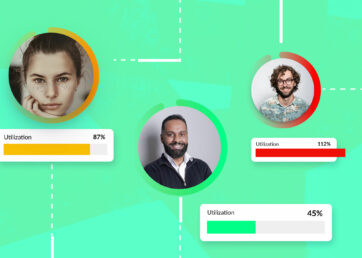Any thriving creative team is supported by a solid advertising agency workflow. This holds them accountable and helps them deliver results for clients. Yes, creativity needs freedom to flow, but it also requires workflows to stay the course.
Traditionally, marketing and media channels have been print (i.e., billboards and magazines) and broadcast (i.e., television or radio). But the advertising landscape has evolved and now includes digital channels like social media, digital advertising, and search engines among others.
That means even within traditional creative services, there are many campaign options, and that means a multitude of workflows.
So where do you start? And how do you optimize your ad agency workflow? We’re here to help you figure it out.
In this article 📖
Our expert roll call
Expect actionable insights from the following agency veterans:
- Shantal Gonzalez, experienced Director of Project Management for leading agencies like MRM.
- Leigh Buttrey, Head of Client Accounts & Paid Media Specialist at Adriana Stein Marketing, and Co-founder of Forank.
You’ll see their advice and tips throughout the article as we attempt to create more context and give you practical tips.
What is a workflow?
“A workflow is a system that allows you to identify each step’s input and output and the correct order to get from one point to another.” – Agency veteran Shantal Gonzalez.
What is an advertising (ad) agency workflow specifically?
Advertising agency workflows come under the umbrella of general agency workflows.
It refers to the systematic process and sequence of activities that an advertising agency follows to execute advertising campaigns and deliver services to clients. It outlines the steps, tasks, and interactions involved in creating, planning, and implementing campaigns from start to finish.
But there’s a catch. (Isn’t there always?)
Not only do advertising agency workflows differ from workflows for other agency types—say recruitment or software development. They’ll change depending on the specific type of advertising or creative work your agency offers.
And last but not least, even if it’s the same type of agency, they may still vary depending on the agency’s strategy.
8 benefits of an advertising agency workflow
From agency scalability to team collaboration and accountability, discover eight benefits of creating workflows for your ad agency.
Better resource utilization (across projects)
An ad agency workflow that provides a clear direction of travel helps your project manager(s) to optimize resource allocation. Because you have a roadmap, you can match the right skills and people against not just one but all agency projects.
That creates more efficient resource utilization across your agency. Meaning you can respond to bottlenecks and project changes without over-allocating your team.
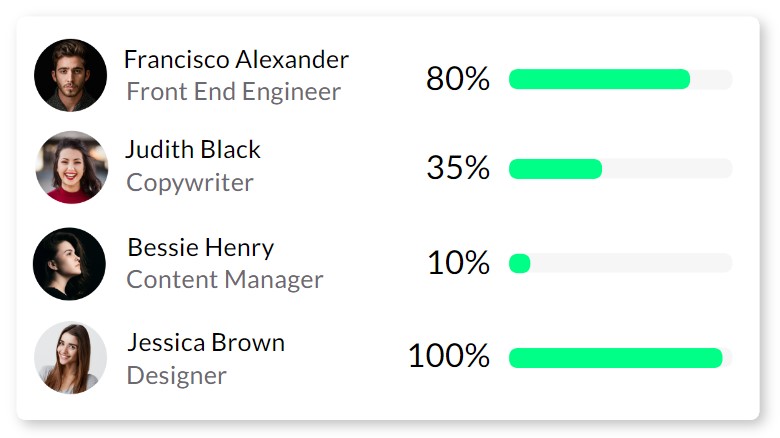
An example of how individual utilization rates appear in Resource Guru’s software.
2. Team collaboration (key to agency survival)
“Having workflows allows each discipline to understand its contribution to successful outputs as an agency,” says Shantal.
But workflows don’t just create a greater understanding of how you fit into the broader project picture. You’ll also see how others fit into the picture, which enables better team collaboration.
And it’s no secret: Compared to other organizations, agencies need high degrees of team collaboration across projects to survive.
Team accountability
Having workflows that suit your ad agency “holds everyone on the project accountable,” says Leigh. Because everyone knows “each step needs to be done in order for the campaign to be a success.”
Not only will the right people work on the right tasks. But your resources will know who’s accountable for deliverables throughout the project life cycle.
4. Team well-being (through better resource planning)
“When we don’t follow the proper workflow, we sacrifice our talent and ability to deliver fantastic work,” warns Shantal.
In short, workflows give you an overview of who’s responsible for what, from project initiation to closure.
That insight makes for masterful workload planning. You know, the kind that keeps projects rolling along on time and on budget. Without sacrificing your team’s health and risking agency burnout.
5. Mitigating human error
“Without workflows and processes, things are easily missed, especially if you’re setting a client up from scratch,” says Leigh.
In the case of digital advertising, for example, “it would be a disaster to run ads without conversion tracking.” So it’s crucial to implement workflows that stop “human error” and these key tasks from “being missed,” Leigh warns.
6. Reducing project delays
Deadlines are harder to meet when there’s a workflow gap. You might suffer from lost assets or deliverables (because storing them hasn’t been built into your workflow).
Then, you could get struck by bottlenecks because of inefficient processes—or a lack of them. That’s a lot of avoidable bumps in the road that can cause late completion or project failure.
7. Client satisfaction and retention
Clients don’t need to know the inner workings of your agency. But, if your internal processes aren’t fit for purpose, causing human error, poor deliverables, and project delays, they’ll feel the gaps. Ultimately, poor workflows will affect your client-agency relationship.
Long story short: Robust workflows improve service delivery, which can help you keep client satisfaction levels high. And that means clients are more likely to stick around year after year. You may even get some bonus business from client referrals too.
8. Agency scalability
Scalability is a hot topic these days, and every leadership team wants to understand what it takes to scale an agency. Unsurprisingly, that starts with your processes.
Standardized but flexible workflows make it much easier for your agency to scale operations. Scaling with minimal friction helps you grow your client roster and take on more projects without impacting existing clients.
Then, with each iteration, you can improve your workflows or identify opportunities for improvement. Creating these agency efficiencies over time will help you scale even more.
Your 11-step advertising agency workflow process
Now you know the benefits of an advertising agency workflow process, here’s how to build your own.
Step 1. Client discovery and proposal
Before getting into the nitty gritty of client onboarding (or project kick-off), let’s look at client discovery and proposal. Hopefully, this already forms part of your agency project management process. But if not, here’s a brief overview of these stages.
During client discovery, you’ll tick off a few things, including:
- Establishing a budget
- Identifying your client’s goals (including their marketing goals)
- Finding out the initial project scope
- Resource estimation (do you have the right talent for the initial project scope, and are they available?)
First, you’ll use all that info to work out if you’re an agency-client match. If not, signpost client projects to your network. If yes, create a winning client proposal.
Then, if all goes well with your proposal, your client will put ink on paper, and your project can start.
Expert insights from digital advertising use case
Every step of your ad agency workflow “is really important,” says Leigh, Co-founder of Forank. “But the most important one is understanding the client’s marketing goal.”
In the context of digital advertising, and PPC in particular, Leigh emphasizes this needs to be done “before looking at setting up ads,” ideally during client discovery.
That’s so you avoid running ads “for the sake of running ads.” Aka “without any thought behind what the goal of the campaign is” and whether it resonates “on the platform or with the audience targeted,” says Leigh.
Once you’ve understood what your client is trying to achieve and “the best platform and ad strategy” to achieve that, “everything else comes along afterward.”
Step 2. Client onboarding (project kick-off)
Client onboarding is all about getting everyone on the same page. That includes your in-house team, the client, and, if relevant, other external stakeholders.
You’ll want to clarify:
- Your client’s goals (ensuring you really understand them)
- The project requirements
- Deliverables
- Project stakeholders
- Internal and external communication expectations (Hint: setting these early can build agency-client trust. It may also prevent those long client response times that hinder project progress.)
Pro tip: You’ll also want to outline a flexible project schedule with milestones and key deadlines. But ensure they align with the budget, preferred timeframe for project closure, and resource availability.
Expert insights and ad agency use case
Having client onboarding as part of your workflow means “there is a process to go through,” says Leigh.
For example, when it comes to digital ads, that process typically includes “gaining access to their tech stack, setting up ad accounts, setting up conversion tracking.” All of which ensure smooth project initiation.
Pro tip: Get anything you need from the client to start work on the project upfront. Consider tangible things like getting the right tech permissions, brand guidelines, visual assets, FAQ documents, or subject matter expert interviews.
Step 3. Finalize your project team structure and responsibilities
Internally, you’ll want to define your project team’s roles and responsibilities and, if relevant, set flexible key performance indicators (KPIs).
The sooner you establish how your team members fit into the bigger picture, the easier it is to forecast resources needed.
Then you can better estimate:
- The project workload
- The people you need to achieve project success
- How much you’ll need them
Pro tip: Host an internal kick-off meeting to outline the project. It’ll give your team a chance to feedback on the effort vs. scope and whether project goals are realistic.
H3: Step 4. Resource planning and management
Agency resource planning and management is something you’ll do throughout the entire ad agency workflow.
Whether that’s estimating resources after your client discovery meeting. Or finalizing your agency project team structure before kickoff. You’ll also ensure you match the right skills against tasks throughout the project.
For the rest of your ad agency workflow, you’ll likely revisit:
- Resource allocation. How you manage your team’s time and workload against project needs and availability.
- Resource scheduling. How you schedule your team based on project needs, task needs, and resource capacity.
- Resource optimization. How you plan team workload or reallocate tasks balancing resource utilization against project needs.
- Resource monitoring and control. As part of project monitoring and control, you’ll also want to track the use of resources.
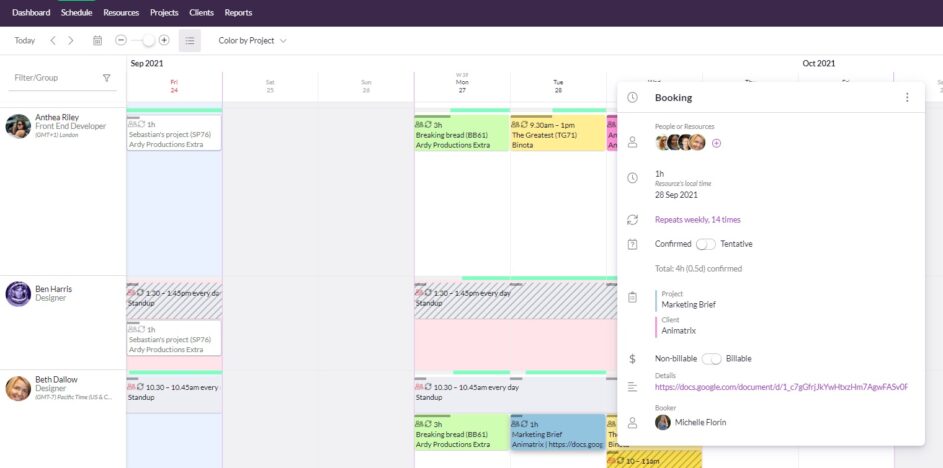
Schedule view in Resource Guru, scheduling the initial meeting about the brief.
Step 5. Planning and strategy
The planning and strategy stage of your ad agency workflow involves diving into research. The insights you glean here will help you get specific about your client’s advertising and marketing strategy.
You can then create a clear project roadmap, including:
- The outline of your approach
- Any specific messaging and communication needs
- Distribution methods and ideal marketing channels (i.e., TV, radio, digital, social media, print, out-of-home)
- Ideal tactics
- Clearly defined goals and objectives (i.e., project goals, objectives, and KPIs)
Some research methods include market research, existing performance analytics, and competitor analysis. Market research helps you understand the target audience. Performance analytics show what’s already working and what isn’t. Competitor analysis highlights market trends and competitor gaps.
Step 6. Creative brief development
Before assigning creative tasks to the team, you must create clear project briefs based on your strategy.
A clear brief details:
- Specific task instructions
- Critical information (i.e., the target audience and purpose of the work)
- Deadlines
That way, your team will know what you expect from their time on the project. Plus, giving a clear outline of creative tasks should reduce revisions while creating accountability for any amendments (preventing bottlenecks).
Step 7. Production
You’ve got your strategy mapped out, and you’ve made and assigned project briefs. Now it’s time to let your creatives be creative.

Before production begins, you might encourage ideation and conceptualization as ways to explore different possibilities and approaches to creative work.
Some methods include:
- Brainstorming sessions
- Mood boards
- Creative workshops
These activities also give departments and team members space to give feedback about whether an approach is realistic. Thus, aligning teams, further building trust, and fostering team collaboration.
Pro tip: Remember to factor in time for internal reviews before shipping deliverables for client feedback and approval.
Step 8. Quality assurance
Like resource planning and management, quality assurance is something you’ll want to embed throughout the workflow. Having quality assurance in place throughout ensures deliverables meet the client’s expectations and project needs.
In an ad agency context, quality assurance could be:
- Fact-checking or reviewing creative work like copy or design
- Double-checking that conversion tracking is set up correctly for digital ads
Pro tip: You know it, we know it. It’s easier to tweak a draft of a creative deliverable than the final version. So create space for iterative feedback both internally and externally throughout the workflow. That means scheduling reviews, revisions, and feedback sessions before shipping deliverables for client approval.
Resource monitoring and optimization
Quality assurance also applies to your resources (i.e., resource monitoring and optimization.) For example, monitoring team capacity to ensure no one is overallocated is a quality control process.

Resource Guru gives you clear, real-time insight into everyone’s capacity.
But remember, resource monitoring isn’t about micromanaging.
It’s about finding ways to use your team more effectively and help overburdened team members. That includes reallocating work or finding contractors to help rebalance an over-utilized team member’s workload.
Step 9. Client feedback and next steps
Hopefully, you’ve had iterative feedback throughout. But now it’s time to present any final deliverables needed for further project execution or production.
Ideally, you’ll want to do this in a meeting rather than over email. You can then add any context to your decision-making and show explicitly how the work meets the project goals.
In the meeting, remember to gather:
- Feedback
- Revision suggestions/requests (i.e., changes to an ad’s messaging or design)
- Next steps
Once you have everything you need, you’ll want to action client feedback before getting final approval.
Pro tip: If you meet virtually, you could request consent to record the meeting. That means everyone can refer back to the recording for reference. Plus, you’ll have documented the agreed next steps and can assign team tasks with peace of mind.
Step 10. Additional production and strategy delivery
When your client has signed off on the creative deliverables, you can go into other production and strategy.
In an ad agency context, this could mean:
- Sharing the now-approved video ad with the relevant media publisher (i.e., television or digital video)
- Deploying the now-approved ad copy per your digital advertising strategy (i.e., PPC)
Pro tip: The next iteration of your strategy will likely bring new work. That means you’ll need to assign new tasks to people with the right skill set. But remember, don’t just factor in new timelines and budget considerations. To keep your people happy, healthy, and productive, revisit your team capacity.
Step 11. Evaluation (performance analysis)
If your client campaign is continuous, you’ll want to complete a performance analysis throughout each iteration. That could be analyzing ad performance to find successes and failures so you can optimize your strategy moving forwards.
If you’re officially closing your project, you’ll want to do a final evaluation with a performance report. Not sure where to start? Close out your projects correctly and diligently with our free project closure checklist.
Whether you’ve delivered a one-off or monthly project, give your client some recommendations.
Recommendations could include:
- Specific data-informed strategies to enhance future performance
- Other suggestions based on wider project successes or areas for improvement
Pro tip: Don’t forget to analyze your resource utilization rates, scheduled time, and billable hours throughout the project. Dig into data about resource gaps, over-allocation, and under-allocation. Ask yourself whether poor resource planning or management caused bottlenecks or project delays. Use the insights to optimize resources (and increase profitability) for future projects.

An example of how Resource Guru tracks utilization rates and billable vs. non-billable hours.
Now that we’ve got a good idea of what building an advertising agency workflow looks like, let’s get practical and take a look at a couple of use cases.
Ad agency workflows: Examples and use cases
Traditional creative services use case
Creative services fall under the umbrella of traditional ad agency work. These services involve creating, planning, and executing advertising campaigns and marketing strategies on behalf of clients. It includes producing advertising assets like video, copy, or graphics and then distributing them across relevant media channels.
Overview of a traditional ad asset creation workflow
When creating assets to distribute via traditional media channels, your workflow may look something like this:
- The account management team receives client brief
- The account management team passes the client brief to the creative team
- The creative team brainstorms ideas (ideation)
- The creative team drafts the initial design for the advertising campaign (conceptual design)
- Account management and the creative team reach a consensus before further production
- An in-house comprehensive creative brief is produced and shared with relevant people/departments
- Production of ad assets begins
- In-house and client feedback is gathered and shared
- Final revisions based on feedback
Of course, this is a general idea of a workflow that you would naturally tailor to suit a specific campaign.
Digital advertising workflow use case
Digital, such as pay-per-click (PPC), falls under online or non-traditional ad work.
According to agency veteran Leigh Buttrey, your “marketing goal” is key to determining the specifics of your digital advertising workflow.
“When running ads, the purpose for them is usually lead generation or online sales,” says Leigh.
“So ensuring conversion tracking is set up correctly from the get-go” is vital in a paid ad workflow. Whereas for, say, a TV ad campaign, tracking direct conversions isn’t necessarily feasible.
The benefit of setting up conversion tracking for paid advertising is that your agency can “ensure the client is seeing results from the media spend,” emphasizes Leigh.
Overview of a typical digital advertising workflow
According to Leigh, a typical workflow of an advertising agency (specifically for paid) ad workflow may involve the following:
- Gaining access to a clients tech stack
- Setting up ad accounts
- Setting up conversion tracking
- Researching competitors and keywords
- Putting together an ad strategy
- Looping in creatives and ad copy before going live
“This is a quick overview. But the process is very similar across the board for all new clients. It only may differ depending on the time of ads you are running,” says Leigh.
With these use cases in mind, let’s talk about workflow optimization.
5 tips to optimize your advertising agency workflow
We didn’t just want to show you how to build your ad agency process and workflow. We wanted to give you actionable tips to optimize your workflow process with each iteration.
To do that, we picked our featured agency expert’s brains and gleaned their juiciest insights.
Here’s what they had to say.
1. Start with the resource
“If you’re working on optimizing team or agency workflow, you need to start with the resource,” says Shantal.
Ask yourself, “Do you have the right talent that understands their roles and responsibilities to help execute?”
If yes, Shantal says, “It’s time to go more granular and look at how you approach the workflow.”
2. Then get granular
Shantal suggests “building the current workflow, breakdown the existing steps, and identifying (clearly and in bullet points) the objective of each of those steps.”
“That will help determine the ‘broken link’” and identify “if each step is hitting those objectives,” says Shantal.
3. Adopt solution thinking
“Once you’ve done this homework, then you go into solution thinking,” says Shantal. At this stage, you can begin “re-arranging, probably eliminating redundancies and identifying efficiencies and new goals.”
Doing this will help you “improve productivity and management” across your ad agency.
4. Consider the type of client
Each client type may come with different needs. So for “e-commerce clients, the workflow will be different to clients who offer a service,” says Leigh.
To account for these differences, Leigh recommends “putting together scenarios and workflows based on the type of client.”
5. Allow your workflow to evolve
Shantal suggests that agencies “allow themselves to evolve workflows based on client or market needs.”
By rolling with the punches and making changes as needed, you can work to “improve productivity and efficiencies operationally.”
Pro tip: Consider the best agency project management methodology for your organization. So in this instance, a flexible PM approach, like agile, will help you evolve workflows over time.
Ad agency workflow software (ditch those spreadsheets for good)
The right ad agency workflow software can save you time and give you peace of mind.
Here are a few features to look out for.
Advertising agency workflow: your secret to growth
An advertising agency workflow is a structured system that ensures the smooth execution of client ad campaigns and projects. Workflows also help improve resource utilization, reduce project delays, and create conditions where your agency can scale.
Your workflow should include key steps like client discovery, strategic planning, creative brief development, and more. Ad agency workflow software makes it even easier to implement your workflows and deliver successful client campaigns.
Sign up to Resource Guru for free, to see how this tool can help improve your ad agency workflow process and management.




